8. Potentilla makaluensis H. Ikeda et H. Ohba in J. Jap. Bot. 67: 149 (1992). [Fig. 33]
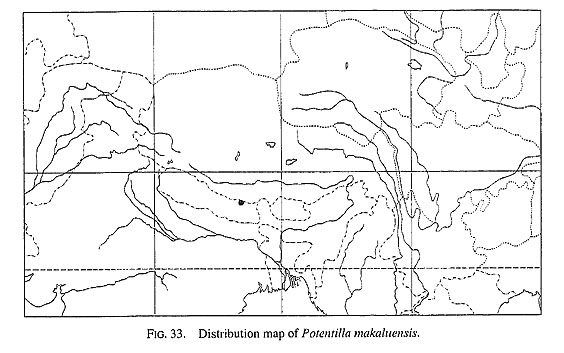
Types: E Nepal; Koshi Zone, Sankhuwa Sabha Distr., Shipton Pass, 4120 m (Suzuki et al. 8880826, 30 July 1988, TI-holotype, A, BM, E, KATH-isotypes).
Perennial acaulescent herbs, with long creeping rhizomes. Rhizomes slender, 1.5-3.5 cm long, with sparse degenerate leaves, the stipules of which surround the rhizomes. Radical leaves oblanceolate, 2-4 cm long, lateral leaflets 4-5 pairs, without smaller leaflets; petiole 4-10 mm long; base of uppermost pair of leaflets cuneate. Leaflets strigose on the petioles and both surfaces, terminal leaflet subsessile, oblong to obovate, 3.0-7.0 mm long, 3.0-4.5 mm wide, serrate, with 5-9 teeth. Auricles of stipules connate, membranaceous, apex rounded.
Peduncles 1.5-4.0 cm long, Cauline leaves simple, oblanceolate, apically 1-3 lobulate; auricles of stipules laminar-form.
Flowers solitary, 1.0-1.5 cm across; hypanthium 0.5-0.8 cm across. Episepals oblong to elliptic, 2.0-3.0 mm long, 1.0-1.5 mm wide, entire, apex acute, nearly glabrous above, lower surface and margin strigose. Sepals elliptic to ovate, 3.0-4.0 mm long, 2.0-3.0 mm wide, entire, apex acute to obtuse, puberulent toward apex above, lower surface and margin strigose. Petals obovate to broad obovate, apex rounded, 5.5-7.0 mm long, 5.0-7.0 mm wide.
Stamens 2.0-3.2 mm long; anthers orbicular, 0.7-1.0 mm long, 0.6-0.9 mm wide. Ovaries ellipsoid to ovoid, 0.7-0.9 mm long, 0.6-1.0 mm wide. Styles lateral, 1.0-1.2 mm long. Stigmas slightly or apparently inflated.
Chromosome number 2n=14.
Distr. E Nepal.
Potentilla makaluensis grows in wet places and forms mats consisting of long, slender rhizomes with a few scaly leaves. This habit is thought to be useful for vegetative reproduction in wet habitats. Potentilla makaluensis is restricted at the upper Arun Valley, E Nepal.
9. Potentilla glabriuscula (T.T. Yü et C.L. Li) Soják in Candollea 43: 453 (1988). Ikeda in Ohba and Akiyama, Alp. Fl. Jaljale Himal 35 (1992). Soják in Bot. Jahrb. Syst. 116: 40 (1994).
BASIONYM: Sibbaldia glabriuscula T.T. Yü et C.L. Li in Acta Phytotax. Sin. 19:516 (1981); in Yü, Pl. Reipubl. Popul. Sin. 37: 343 (1985). Yü et al. in Wu, Fl. Xizang. 2: 669, t. 202, f. 4-9 (1985).
Types: China; Yunnan, Nu Shan (Mekong-Salwin Divide), 3800 m (Yü 22265, 10 Aug. 1938, PE-holotype, E-isotype).
SYNONYMS: P. microphylla D. Don var. glabriuscula auct. non Wall. ex Lehm.; Wu et al., Index Fl. Yunnan. 1: 497 (1984), pro parte.
P. microphylla D.Don var. latiloba auct. non Wall. ex Lehm.; Grierson and Long, Fl. Bhutan 1: 573 (1987), pro parte.
P. microphylla auct. non D. Don; Ku in Wang et al., Vasc. Pl. Hengduan Mts. 1: 850 (1993), pro parte.
Radical leaves oblanceolate, 1.8-5.0 cm long, 0.5-1.0 cm wide, lateral leaflets 3-7 pairs, without smaller leaflets; petiole 3-12 mm long; base of uppermost pair of leaflets cuneate. Leaflets strigose or nearly glabrous beneath; terminal leaflet subsessile, oblong to narrowly obovate, 3.5-4.2 mm long, 2-4 mm wide, serrate, with 3-7 teeth. Auricles of stipules connate, apex rounded.
Peduncles 5-35 mm long. Cauline leaves simple, entire or 3-lobed. Auricles of stipules entire.
Pedicel 3-10 mm long. Flowers 0.4-1.2 cm across; hypanthium 3-7 mm across. Episepals lanceolate to oblong, 1.8-3.0 mm long, 0.4-1.2 mm wide, entire, apex acute or obtuse, nearly glabrous above, lower surface and margin sparsely strigose. Sepals elliptic to ovate, 2.0-3.0 mm long, 1.0-1.8 mm wide, entire, apex acute or obtuse, glabrous or puberulent toward apex above, lower surface and margin sparsely strigose. Petals oblong to elliptic, apex rounded, 3.0-5.0 mm long, 2.0-4.0 mm wide.
Stamens 5-10, 1.3-1.7 mm long; anthers globose to ellipsoid, 0.5-0.7 mm long, 0.4-0.8 mm wide. Ovaries ellipsoid, 0.6-0.8 mm long, 0.4-0.5 mm wide; styles 0.6-0.8 mm long, slender; stigmas slightly inflated.

9a. var. glabriuscula [Figs. 13 (upper) & 34; Pl. 23]
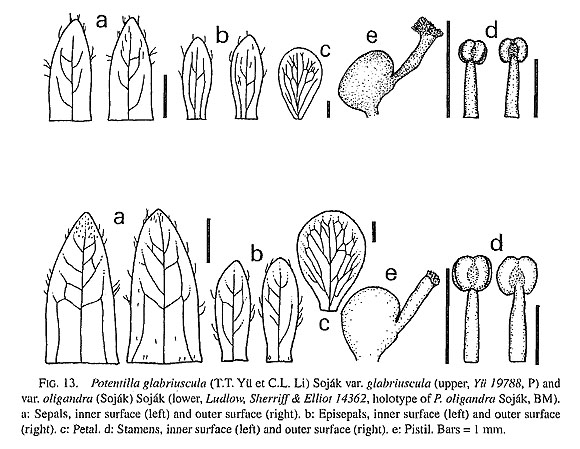
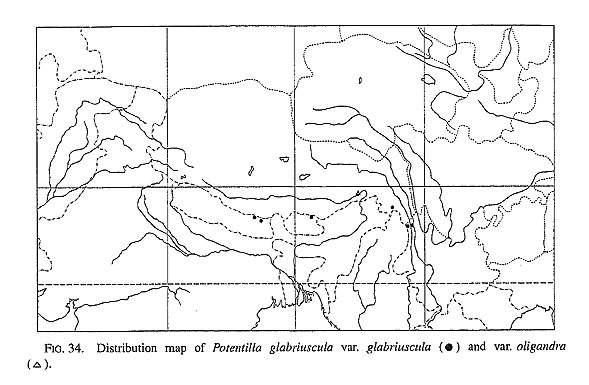
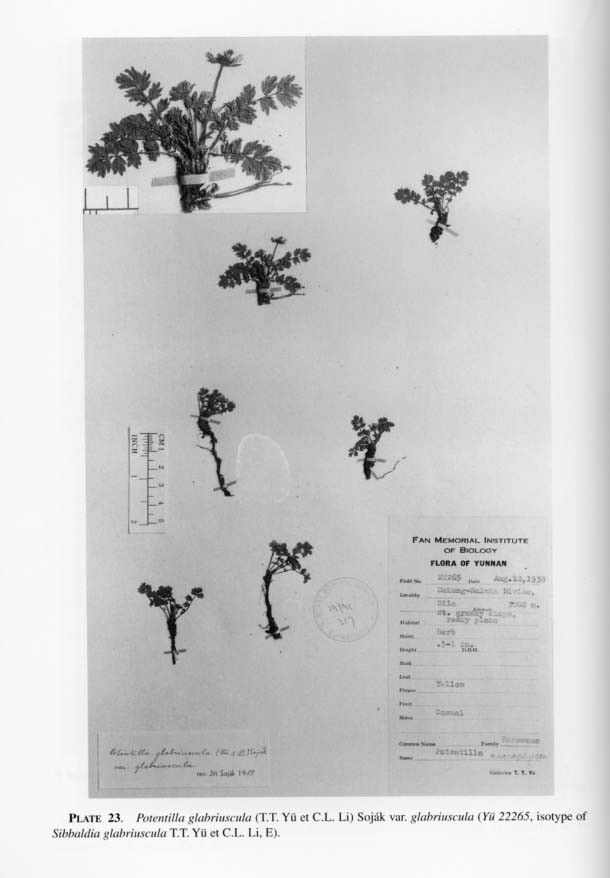
SYNONYMS: P. glabriuscula (T.T. Yü et C.L. Li) Soják var. narimensis Soják in Bot. Jahrb. Syst. 116: 41 (1994).
Types: Bhutan, Narim Thang (Ludlow, Sherriff and Hicks 21361 in 1949, BM-holo-type, E-isotype).
P. microphylla auct. non D. Don; Ku in Wang et al., Vasc. Pl. Hengduan Mts. 1: 850 (1993), pro parte.
P. microphylla D. Don var. glabriuscula auct. non Wall. ex Lehm.; Hand.-Mazz., Symb. Sin. 7: 519 (1933). Wu et al., Index Fl. Yunnan. 1: 497 (1984), pro parte.
Radical leaves 1.8-2.5 cm long, 0.5-1.0 cm wide, lateral leaflets 3-6 pairs; petiole 3-6 mm long; terminal leaflet 3.5-4.2 mm long, 2.5-4.0 mm wide, with 3-5 teeth.
Peduncles 5-12 mm long; pedicel 3-7 mm long. Flowers 0.4-1.0 cm across; hypanthium 3-6 mm across. Episepals 1.8-2.3 mm long, 0.9-1.2 mm wide. Sepals 2.0-2.2mm long, 0.9-1.2 mm wide. Sepals 2.0-2.2 mm long, 1.2-1.5 mm wide. Petals 3.3-4.0 mm long, 2.4-3.0 mm wide.
Stamens 5, 1.3-1.7 mm long; anthers 0.5-0.7 mm long, 0.6-0.8 mm wide. Ovaries 0.6-0.7 mm long, 0.4-0.5 mm wide; styles 0.7-0.8 mm long.
Chromosome number 2n=14.
Distr. E Nepal, Bhutan, China (Yunnan and Xizang).
Potentilla glabriuscula was first described as a species of Sibbaldia (Yü and Li 1981), but Soják (1988) transferred it to Potentilla. Sibbaldia is characterized by having about 5 stamens; the number of stamens of P. glabriuscula varies from 5 to 10. The other characters of P. glabriuscula are same as those of the species of section Leptostylae, which is where it should be placed.
Grierson and Long (1987) used the name P. microphylla var. latiloba for P. glabriuscula.
9b. var. oligandra (Soják) Soják in Bot. Jahrb. Syst. 116: 41 (1994). [Figs. 13 (lower) & 34; Pl. 24]
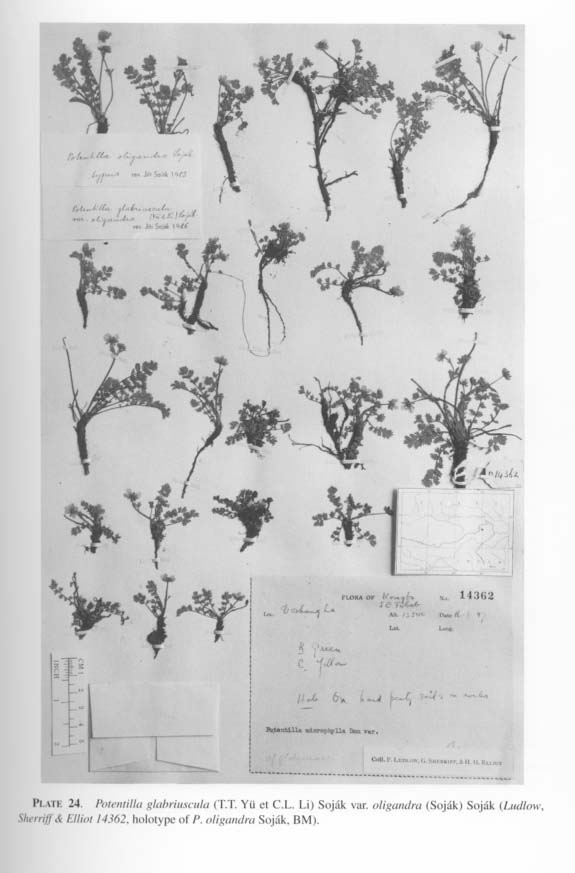
BASIONYM: P. oligandra Soják in  . Nár. Muz. Odd.
. Nár. Muz. Odd.  . 152: 160 (1983).
. 152: 160 (1983).
Types: SE Tibet; Kongbo, Doshong La, 13500 ft. (Ludlow, Sherriff & Elliot 14362, 16 Aug. 1947, BM-holotype, E-isotype).
Radical leaves 2.0-5.0 cm long, 0.5-1.0 cm wide, lateral leaflets 4-7 pairs; petiole 4-12 mm long; terminal leaflet 3-4 mm long, 2-3 mm wide, with 5-7 teeth.
Peduncles 10-35 mm long; pedicel 4-10 mm long. Flowers 0.6-1.2 cm across; hypanthium 4-7 mm across. Episepals 2-3 mm long, 0.4-0.9 mm wide. Sepals 2-3 mm long, 1.0-1.8 mm wide. Petals 3-5 mm long, 2-4 mm wide.
Stamens 1.3-1.5 mm long; anthers 0.5-0.7 mm long, 0.4-0.6 mm wide. Ovaries 0.7-0.8 mm long, 0.4-0.5 wide; styles 0.6-0.7 mm long.
Distr. China (Xizang).
Variety oligandra has 8-10 stamens and is larger than var. glabriuscula, which has about 5 stamens.
10. Potentilla aristata Soják in Candollea 43: 159, t. l, f. 7-9; t. 2, f. 2 (1988). Miehe, Langtang Himal 445, t. D2.58 (1990). Ikeda in Ohba and Akiyama, Alp, Fl. Jaljale Himal 34 (1994). Soják in Bot. Jahrb. Syst. 116: 34 (1994). [Figs. 14 & 35; Pls. 25 & 26]
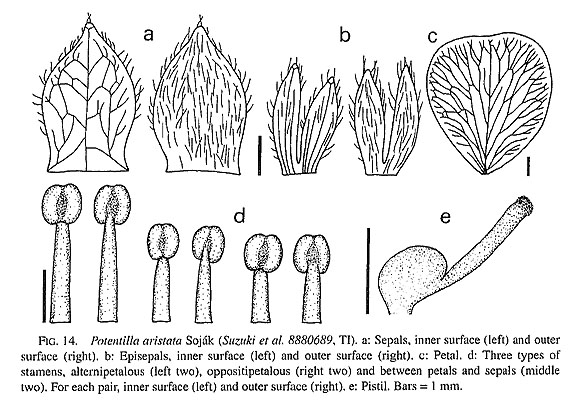
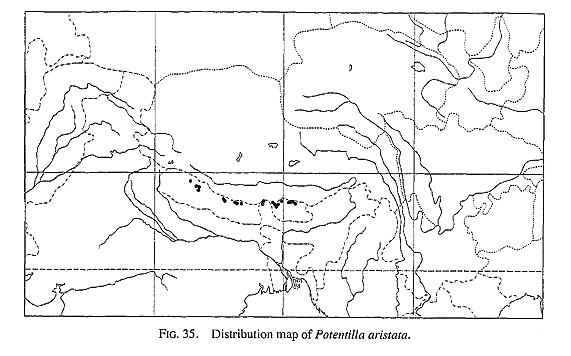
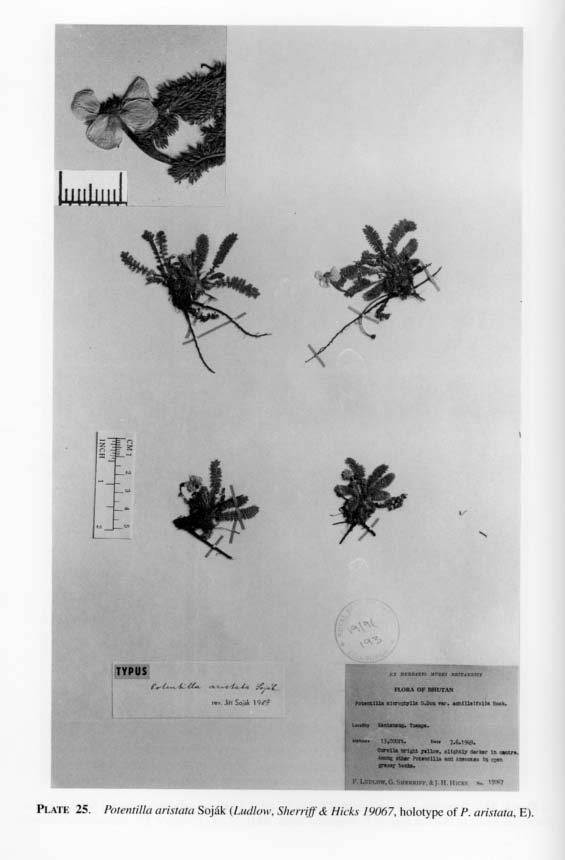
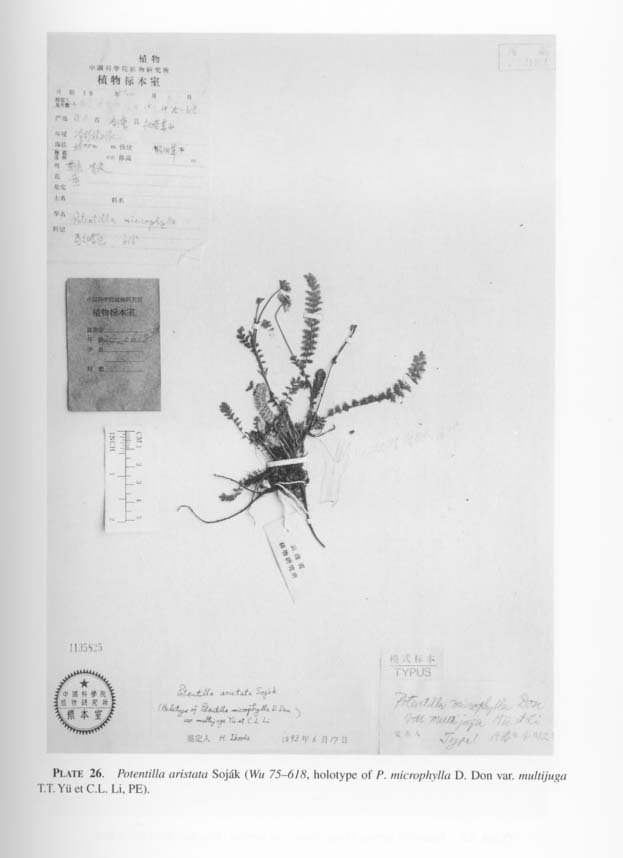
Type: Bhutan; Kantanang, Tsampa, 13000 ft. (Ludlow, Sherriff & Hicks 19067, 7 June 1949, E-holotype).
SYNONYMS: P. microphylla D. Don var. achilleifolia Hook. f., Fl. Brit. Ind. 2: 353 (1878). Wolf, Monogr. Potentilla 682 (1908). Handel-Mazzetti, Symb. Sin. 7: 519 (1933). Kitamura in Kihara, Fauna Fl. Nepal Himal. 152 (1955). Bernardi in Candollea 18: 275 (1963). Nakao, Liv. Himal. Flow. t. 227 (1964). Banerji in Rec. Bot. Surv. Ind. 19(2): 41 (1966). Murata in Hara, Fl. E. Himal. 124 (1966); in Hara, Fl. E. Himal. 2: 53 (1971). Ohashi in Hara and Williams, Enum. Flow. Pl. Nepal 2: 140 (1979). Grierson and Long, Fl. Bhutan 1: 572 (1987).
Type: Sikkim, Lanchen, 12000-14000 ft. (Hooker s.n. in 1849, K-holotype).
P. microphylla. D. Don var. rnultijuga T.T. Yü et C.L. Li in Acta Phytotax. Sin. 18: 8, t. 2, f. 2 (1980); in Yü, Fl. Reipubl. Popul. Sin. 37: 274, t. 41, f. 13 (1985). Yü et al. in Wu, Fl. Xizang. 2: 650, t. 200, f. 8 (1985).
Types: Xizang; Jilung, 3800 m (Wu et al. 75-618, 5 July 1975, PE-holotype, KUN-isotype).
P. microphylla D.Don var. glabriuscula auct. non Wall. ex Lehm.; Yü and Li in Yü, Fl. Reipubl. Popul. Sin. 37: 274 (1985), pro parte. Yü et al. in Wu, Fl. Xizang. 2: 650 (1985), pro parte.
P. microphylla non D.Don; Polunin and Stainton, Flow. Himal. 126 (1984), pro parte.
Radical leaves oblanceolate, 1.5-4.0 cm long, 0.5-1.0 cm wide, lateral leaflets 13-16 pairs, without alternating smaller leaflets; petiole 0.5-0.8 cm long; base of uppermost pair of leaflets cuneate. Leaflets strigose beneath; terminal leaflet subsessile, oblong to narrowly obovate, 2.0-3.0 mm long, 1.5-2.5 mm wide, serrate, with 8-12 teeth. Auricles of stipules free.
Peduncles 1-2 cm long. Cauline leaves simple or with 4 or 5(-9) pairs of leaflets. Auricle of stipules entire.
Pedicel 0.5-1.0 cm long. Flowers 1.0-1.5 cm across; hypanthium 5-8 mm across. Episepals lanceolate to oblong, 2.0-3.0 mm long, 1.5-2.5 mm wide, entire or deeply divided into two lobes, apex acute or obtuse, sparsely strigose on both surfaces. Sepals elliptic to ovate, 2.5-4.0 mm long, 1.5-2.5 mm wide, entire, apex acute or obtuse, nearly glabrous above, lower surface and margin strigose. Petals oblong to elliptic, apex rounded, 6.0-7.0 mm long, 4.5-6.0 mm wide.
Stamens 2.0-3.0 mm long; anthers globose to ellipsoid, 0.5-0.7 mm long, 0.5-0.7 mm wide. Ovaries ellipsoid, 0.7-1.2 mm long, 0.5-0.8 mm wide; styles 1.3-1.8 mm long, slender; stigmas slightly inflated.
Chromosome number 2n=14.
Distr. Nepal, Sikkim, Bhutan, and China (Xizang).
Potentilla aristata has relatively small leaves with many leaflets and has been treated as a variety of P. microphylla (as var. achilleifolia) before Soják (1988) recognized it as a distinct species. In spite of the similarity in gross appearance between P. aristata and P. microphylla s. str., the branching in the two species is quite different. In P. aristata, new shoots are produced and separated from subterranean rhizomes, while in P. microphylla, many lateral stems have many leaves at the base and elongate from the axils of radical leaves. According to the difference in branching types, P. aristata forms rosettes and P. microphylla forms cushions. Potentilla aristata has a few slender roots from subterranean rhizomes while P. microphylla s. str. does not have such roots.
Some individuals of P. aristata have hairs on the dorsal side of the ovaries (or
achenes), and Soják (1988) used the character to distinguish P. aristata from P. microphylla s. str. The hairiness of the ovaries (or achenes) is not stable in P. aristata and the character is not used for distinguishing P. aristata and P. microphylla s. str.
Yü and Li (1980) described P. microphylla var. multijuga collected in Xizang, it is, however, identical with P. aristata. Yü and Li (1985) identified some other specimens of P. aristata as P. microphylla var. glabriuscula Wall. ex Lehm.
11. Potentilla turfosa Hand.-Mazz., Symb. Sin. 7: 518 (1933). Wu et al. Index Fl. Yunnan. 1: 499 (1984). Yü and Li in Yü, Fl. Reipubl. Popul. Sin. 37: 275 (1985). Yü et al. in Wu, Fl. Xizang. 2; 651 (1985). Ku in Wang et al., Vasc. Pl. Hengduan Mts. 1: 850 (1993). Soják in Bot. Jahrb. Syst. 116: 43 (1994).
Types: China; NW Yunnan, Mekong-Salwin Katte, bei der Alm Dotitong am Si-la, 3900 m (Handel-Mazzetti 8899, 16 June 1916, W-lectotype, WU-isotype, not seen).
Radical leaves oblanceolate, 3-11 cm long, 0.7-2.0 cm wide, lateral leaflets 3-8 pairs, usually with smaller leaflets between uppermost and next uppermost pair of leaflets; petiole 1-2 cm long; base of uppermost pair of leaflets cuneate. Leaflets sparsely strigose beneath; terminal leaflet sub-sessile, oblong to narrowly obovate, 5-10 mm long, 3-7 mm wide, serrate, with 7-18 teeth. Auricles of stipules free.
Peduncles 3-5 cm long. Cauline leaves simple or with 1-4 pairs of leaflets.
Pedicel 1-5 cm long. Flowers 0.8-1.5 cm across; hypanthium 4-8 mm across. Episepals oblong to obovate, 1.5-3.0 mm long, 0.8-1.2 mm wide, entire or deeply divided into two lobes, apex acute or obtuse, sparsely strigose on both surfaces. Sepals elliptic to ovate, 3.0-3.5 mm long, 2.0-3.0 mm wide, entire, apex acute or obtuse, puberulent toward apex above, sparsely strigose beneath. Petals oblong to elliptic, apex rounded, 5.0-6.5 mm long, 4.0-6.0 mm wide.
Stamens 1.0-2.2 mm long; anthers globose to ellipsoid, 0.5-0.8 mm long, 0.6-0.7 mm wide. Ovaries ellipsoid, 0.5-0.9 mm long, 0.5-0.6 mm wide; styles 0.6-0.9 mm long, slender; stigmas slightly inflated.

11a. var. turfosa [Figs. 15 & 36; Pl. 27]
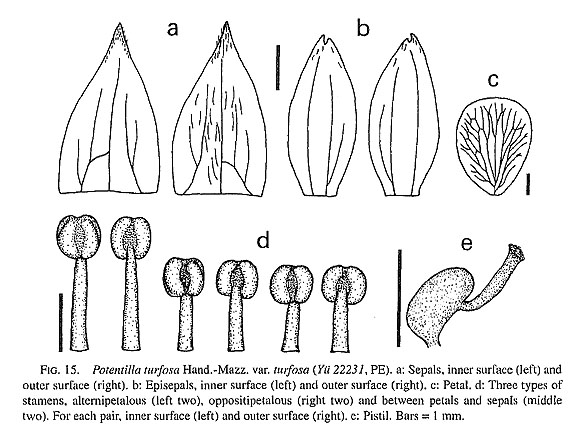
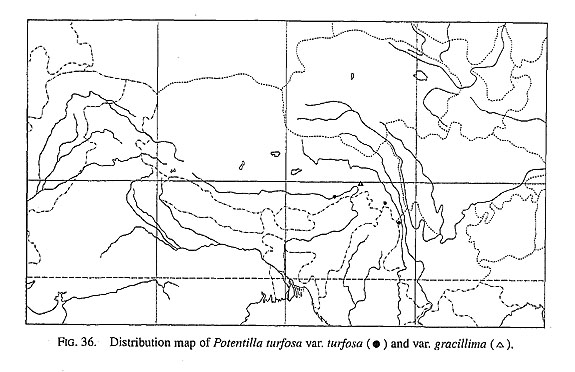
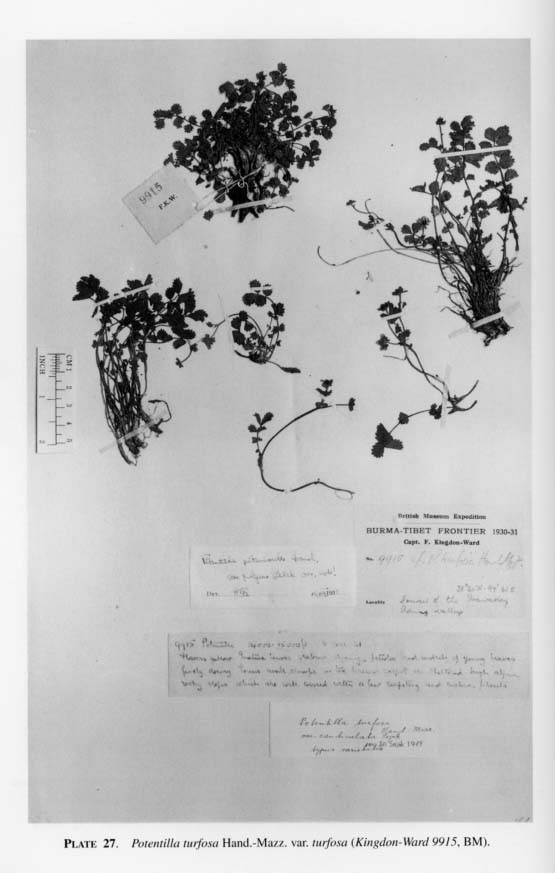
SYNONYM: P. microphylla D.Don var. glabriuscula auct. non Wall. ex Lehm.; Wu et al., Index Fl. Yunnan. 1: 497 (1984), pro parte.
Radical leaves 3.5-11 cm long, 1.2-2.0 cm wide, lateral leaflets 5-8 pairs; petiole 1.0-2.0 cm long; terminal leaflet 6-10 mm long, 4-7 mm wide.
Peduncles 3-5 cm long; pedicel 1-5 cm long. Flowers 1.0-1.5 cm across; hypanthium 4-8 mm across. Episepals 2-3 mm long, 0.8-1.2 mm wide. Sepals 3.0-3.5 mm long, 2-3 mm wide. Petals 5.0-6.5 mm long, 4.5-6.0 mm wide.
Stamens 1.5-2.2 mm long; anthers 0.5-0.8 mm long, 0.6-0.7 mm wide. Ovaries 0.7-0.9 mm long, 0.5-0.6 mm wide; styles 0.7-0.9 mm long.
Distr. China (Yunnan and SE Xizang).
11b. var. gracilescens (Soják) H. Ikeda et H. Ohba, comb. nov. [Fig. 36; Pl. 28]
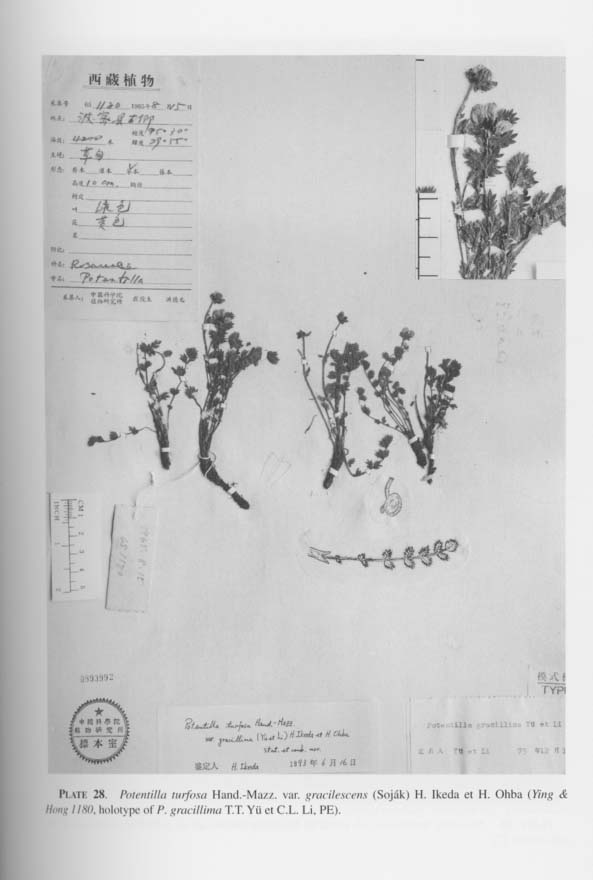
BASIONYM: P. glabriuscula (T.T. Yü et C.L. Li) Soják var. gracilescens Soják in Bot. Jahrb. Syst. 116: 41 (1994).
Type: Xizang; Bomi, 4200 m (Ying & Hong 1180, PE-holotype, type of P. gracillima T.T. Yü et C.L. Li).
SYNONYMS: Potentilla gracillima T.T. Yü et C.L. Li in Acta Phytotax. Sin. 18: 9 (1980); in Yü, Fl. Reipubl. Popul. Sin. 37: 274 (1985). Yü et al. in Wu. Fl. Xizang. 2: 650, t. 200, f. 1-7 (1985). Ku in Wang et al., Vasc. Pl. Hengduan Mts. 1: 850 (1993).
P. turfosa Hand.-Mazz. var. caudiculata Soják in Bot. Jahrb. Syst. 116: 44 (1994), excl. Nepalese collection, Stainton 620 (BM).
Type: Burma-Tibet frontier, sources of the Irrawaddy, Adung Valley, 28°20'N, 97°40'E (Kingdon-Ward 9915 in 1931, BM-holotype).
Radical leaves 3-7 cm long, 0.7-1.2 cm wide, lateral leaflets 3-5 pairs; petiole 1-2 cm long; terminal leaflet 5-7 mm long, 3-4 mm wide, with 7-12 teeth.
Peduncles 1.5-2.0 cm long; pedicel 1.5-2.0 cm long. Flowers 0.8-1.2 cm across; hypanthium 5-7 mm across. Episepals 2-3 mm long, 0.8-1.2 mm wide. Sepals 3.0-3.5 mm long, 1.5-2.5 mm wide. Petals 5-6 mm long, 4-5 mm wide.
Stamens 1.0-1.2 mm long; anthers 0.5-0.6 mm long. Ovaries 0.5-0.6 mm long; styles 0.6-0.7 mm long.
Distr. China (SE Xizang).
Soják (1994a) recognized P. gracillima as a variety of P. glabriuscula, but changed the epithet to P. glabriuscula var. gracilescens. Potentilla turfosa and P. glabriuscula are different in the stipules of radical leaves: P. turfosa has two free auricles while P. glabriuscula has a single auricle. The type specimen of P. gracillima has two free auricles, placing it with P. turfosa.
12. Potentilla turfosoides H. Ikeda et H. Ohba, sp. nov. [Figs, 16 & 37; Pl. 29]
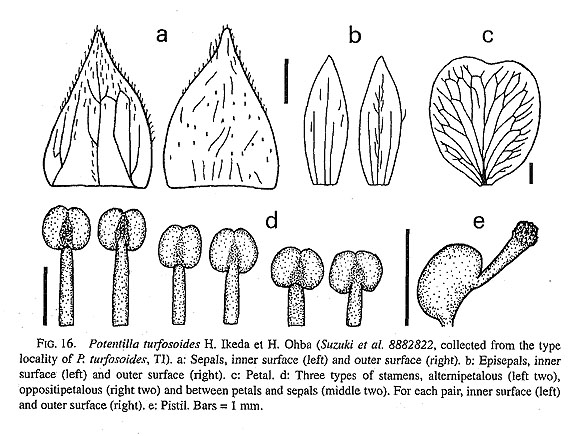
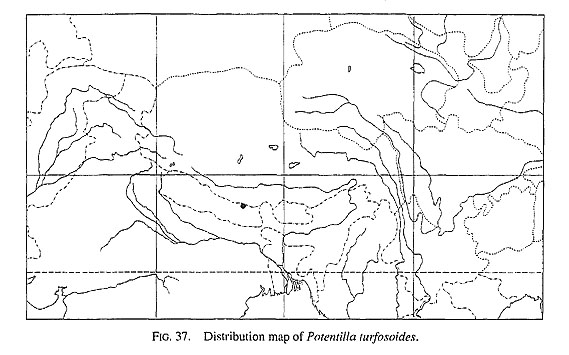
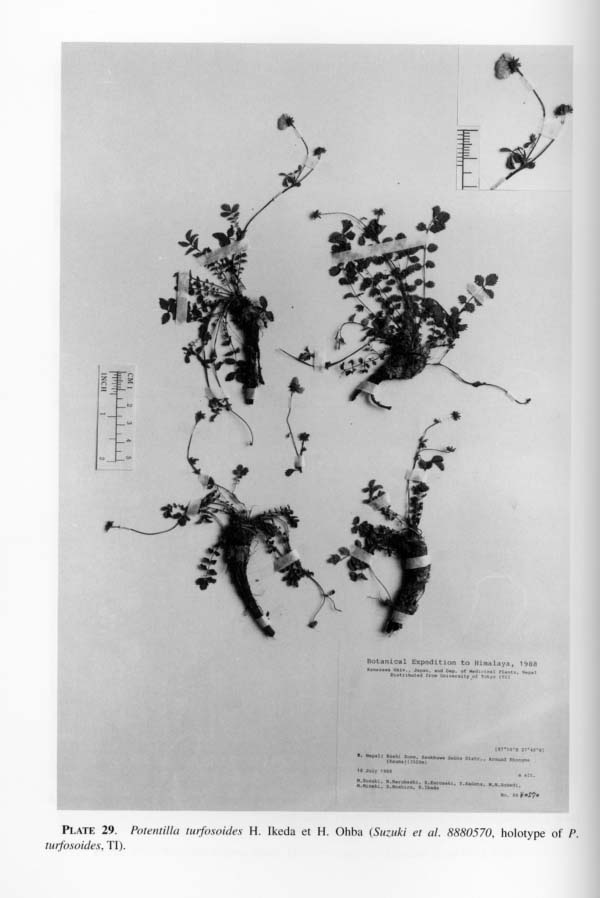
Differt Potentillae turfosae Hand.-Mazz. auriculis stipularum foliorum cauliferorum extus connatis nec liberis.
Types: E Nepal; Koshi Zone, Sankhuwa Sabha Distr., around Khongma, 3500 m (Suzuki et al. 8880570, TI-holotype, A, BM, E, KATH-isotypes).
SYNONYM: P. turfosa Hand.-Mazz. var. caudiculata Soják in Bot. Jahrb. Syst. 116:44 (1994), pro parte.
Radical leaves oblanceolate, 3.5-11 cm long, 1.2-2.0 cm wide, lateral leaflets 5-8 pairs, usually with smaller leaflets between uppermost and next uppermost pair of leaflets; petiole 1-2 cm long; base of uppermost pair of leaflets cuneate. Leaflets sparsely strigose beneath; terminal leaflet subsessile, oblong to narrowly obovate, 6-10 mm long, 4-7 mm wide, serrate, with 12-18 teeth. Auricles of stipules free.
Peduncles 3-5 cm long. Cauline leaves with 2-4 pairs of leaflets. Auricles of stipules of lower leaves connate in lower half to abaxial side of peduncles, entire; auricles of stipules of upper leaves entire or serrate, with 2-4 teeth.
Pedicel 1-5 cm long. Flowers 1.0-1.5 cm across; hypanthium 4-8 mm across. Episepals oblong to obovate, 2.0-3.0 mm long, 0.8-1.2 mm wide, entire or deeply divided into two lobes, apex acute or obtuse, sparsely strigose on both surfaces. Sepals elliptic to ovate, 3.0-3.5 mm long, 2.0-3.0 mm wide, entire, apex acute or obtuse, puberulent toward apex above, lower surface and margin sparsely strigose. Petals oblong to elliptic, apex rounded, 5.0-6.5 mm long, 4.5-6.0 mm wide.
Stamens 1.5-2.2 mm long; anthers globose to ellipsoid, 0.5-0.8 mm long, 0.6-0.7 mm wide. Ovaries ellipsoid, 0.7-0.9 mm long, 0.5-0.6 mm wide; styles 0.7-0.9 mm long, slender; stigmas slightly inflated.
Chromosome number 2n=28.
Distr. E Nepal.
Although P. turfosoides is similar to P. turfosa in gross appearance, it differs in the nature of the stipules of the cauline leaves. The stipules of P. turfosoides surround the stem and are connate with each other; in P. turfosa they are not connate. Potentilla turfosoides occurs in the upper Arun Valley, E Nepal.
iii. Series Pedunculares T.T. Yü et C.L. Li in Acta Phytotax. Sin. 18: 5 (1980); in Yu, Fl. Reipubl. Popul. Sin. 37: 265 (1985), as "Pedunculatae".
13. Potentilla peduncularis D. Don, Prodr. Fl. Nepal. 230 (1825). Franch. in DC, Prodr. 2: 583 (1825). Lehm., Pugill. 3: 15 (1831); Rev. Potentilla. 66 (1856). Hook. f., Fl. Brit. Ind. 2: 351 (1878), excl. var. clarkei. Franchet, Pl. Delavay. 3: 213 (1890). Wolf, Monogr. Potentilla 677 (1908). H. Léveillé in Cat. Pl. Yun-Nan 232 (1917). Handel-Mazzetti in Acta Hort. Gothob. 13: 322 (1939). Fletcher in Notes Roy. Bot. Gard. Edinb. 20: 213 (1950), pro parte. Bernardi in Candollea 18: 275 (1963). Spring Fl. Sikkim Himal. t. 13 (1963). Murata in Hara, Fl. E. Himal. 124 (1966). Nasir and Ali in Fl. W. Pakist. 358 (1972). Malla et al. in Bull. Dept. Med. Pl. Nepal 7: 79 (1976). Ohashi in Hara and Williams, Enum. Flow. Pl. Nepal 2: 106 (1979). Polunin and Stainton, Flow. Himal. 126, t. 37 (1984). Wu et al., Index Fl. Yunnan. 1: 497 (1984). Yü and Li in Yü, Fl. Reipubl. Popul. Sin. 37: 265, t. 40, f. 3 & 4 (1985), pro minor parte. Yü et al. in Wu, Fl. Xizang. 2: 647 (1985), pro parte, Grierson and Long, Fl. Bhutan 1: 571 (1987). Soják in Candollea 43(1): 163, t. 3, f. 6, 7 & 10; t. 5, f. 4 (1988). Miehe, Langtang Himal 445 (1990). Ikeda in Ohba and Akiyama, Alp. Fl. Jaljale Himal 36 (1992). Ku in Wang et al., Vasc. Pl. Hengduan Mts. 1: 848 (1993), pro minor parte.
Type: Nepal; Gosainthan (Wallich s.n., BM-holotype).
Radical leaves oblanceolate, 2.5-25 cm long, 0.8-6.5 cm wide, lateral leaflets 5-25 pairs, usually without alternating smaller leaflets; petiole 0.5-5.0 cm long; base of uppermost pair of leaflets decurrent. Leaflets sericeous or strigose, especially on veins beneath; terminal leaflet sessile, oblong to narrowly obovate, 0.5-3.0 cm long, 0.3-1.5 cm wide, serrate, with 3-30 teeth. Auricles of stipules connate, apex rounded.
Peduncles 2-16 cm long. Cauline leaves simple or with 1 or 2 pairs of leaflets. Auricles of stipules entire or serrate, with 3-5 teeth.
Pedicel 1.0-3.5 cm long. Flowers 1.0-3.5 cm across; hypanthium 7-15 mm across. Episepals oblong to obovate, 3-7 mm long, 1.5-4.0 mm wide, entire or with 3 teeth,
apex acute or obtuse, sparsely strigose above, sericeous or strigose beneath. Sepals elliptic to ovate, 3-8 mm long, 4-5 mm wide, entire, apex acute or obtuse, puberulent toward apex above, sericeous beneath. Petals oblong to elliptic, apex rounded, 6.0-14.5 mm long, 6.0-13.5 mm wide.
Stamens 2.5-5.0 mm long; anthers globose to ellipsoid, 0.8-1.7 mm long, 0.8-1.5 mm wide. Ovaries ellipsoid, 0.5-1.5 mm long, 0.5-10 mm wide; styles 1.4-2.2 mm long; stigmas slightly inflated.
Potentilla peduncularis shows wide morphological variation of serration and hairi-ness of the leaves and ovaries.

13a. var. peduncularis [Figs. 17 & 38; Pl. 30]
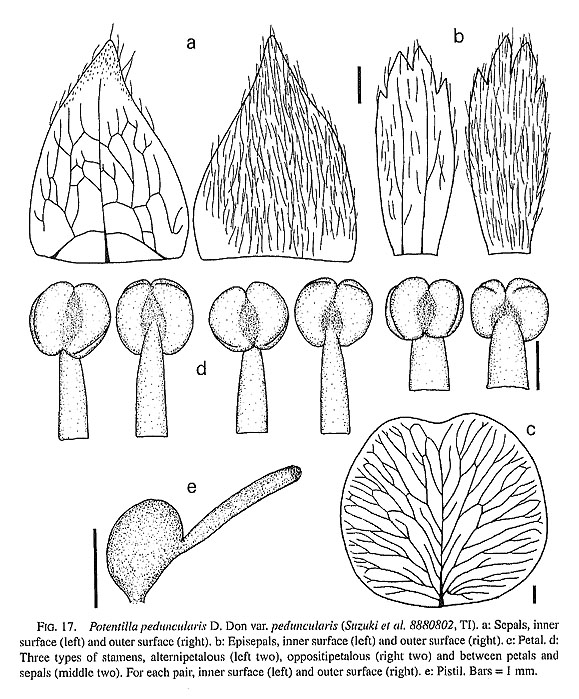
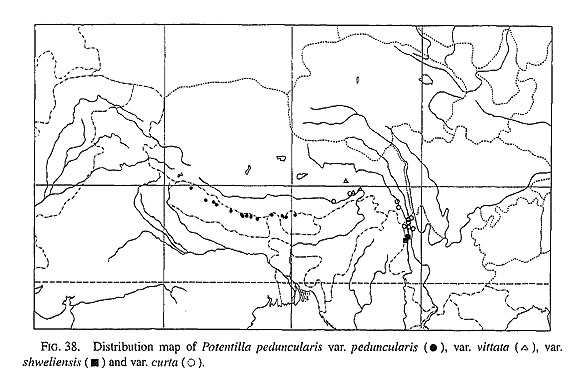

SYNONYMS: P. peduncularis D. Don var. elongata T.T. Yü et C.L. Li in Acta Phytotax. Sin. 18: 8, t. 1, f. 4 (1980). Wu et al., Index Fl. Yunnan. 1: 497 (1984). Yü and Li in Yü, Fl. Reipubl. Popul. Sin. 37: 266 (1985). Yü et al. in Wu, Fl. Xizang. 2: 648 (1985).
Type: China; Yunnan, Gongshan (K. M. Feng 8287, 9 Oct. 1940, PE-holotype).
P. remota Soják in Preslia (Praha) 63: 335 (1991), based on P. peduncularis D.Don var. elongata T.T. Yü et C.L. Li.
P. peduncularis D. Don var. abbreviata T.T. Yü et C.L. Li in Yü, Fl. Reipubl. Popul. Sin. 37: 266 (1985). Yü et al. in Wu, Fl. Xizang. 2: 648 (1985), nom. illeg. (without Latin description and no indication of type specimen).
Radical leaves 14-25 cm long, 2-6 cm wide, lateral leaflets 10-15 pairs; petiole 2-5 cm long; terminal leaflet 1.5-3.0 cm long, 0.5-1.0 cm wide, with 10-15 teeth.
Peduncles 6-15 cm long; pedicel 1.5-3.0 cm long. Flowers 2.0-3.5 cm across; hy-panthium 8-12 mm across. Episepals 6-7 mm long, 2.5-3.5 mm wide, with 3 teeth. Sepals 6-7 mm long, 4-5 mm wide. Petals 12.5-14.5 mm long, 12.0-13.5 mm wide.
Stamens 4-5 mm long; anthers 1.2-1.7 mm long, 1.0-1.5 mm wide. Ovaries 1.2-1.5 mm long, 0.8-1.0 mm wide; styles 1.8-2.2 nun long.
Distr. NW India, Nepal, Sikkim, Bhutan, and China (Yunnan, Sichuan, and Xizang).
Chromosome number 2n=42.
Variety peduncularis is common and is a dominant in alpine grasslands in E Nepal.
Although Soják (1991) recognized P. peduncularis var. elongata at the species rank (as P. remota), the habit of the type specimen is believed to be a lower elevation form of P. peduncularis var. peduncularis.
Although P. peduncularis var. abbreviata was proposed by Yü and Li in Fl. Reipubl. Pop. Sin. 37: 266 (1985), the diagnosis was written in Chinese and no type was indi-cated.
13b. var. shweliensis (Fletcher) H. Ikeda et H. Ohba, stat. et comb. nov. [Figs. 18 & 38; Pl. 31]
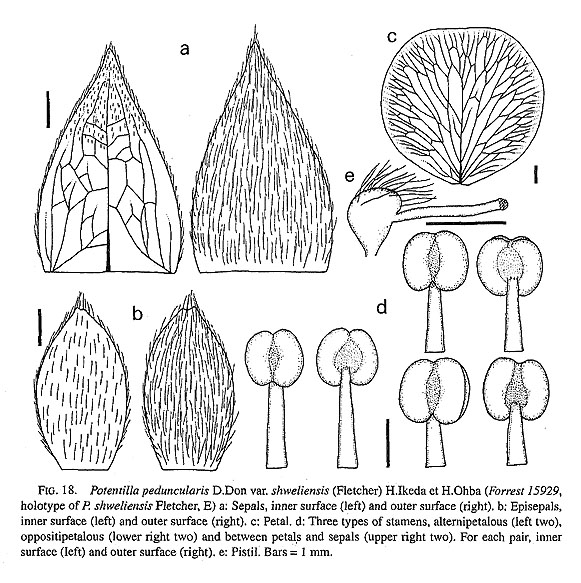
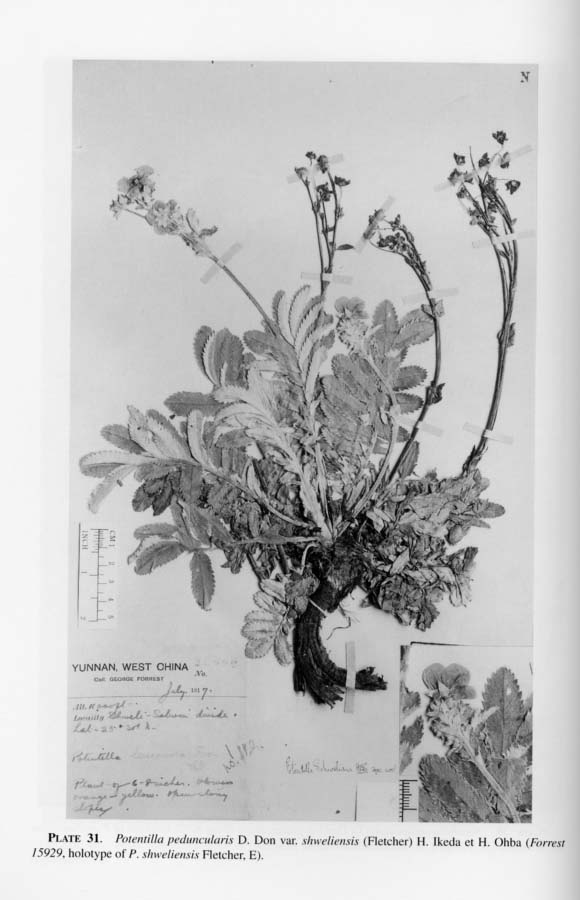
BASIONYM: P. shweliensis Fletcher in Notes Roy. Bot. Gard. Edinb. 20: 215 (1950). Wu et al., Index Fl. Yunnan. 1: 498 (1984).
Type: China; Yunnan, Shweli-Salwin Divide, 25°30'N, 11000 ft. (G. Forrest 15929, July 1917,E-holotype).
Radical leaves 8-15 cm long, 3.0-6.5 cm wide; petiole 2-4 cm long; terminal leaflet 2.0-3.0 cm long, 1.0-1.5 cm wide, with 20-30 teeth.
Peduncles 10-16 cm long; pedicel 1.5-3.5 cm long. Flowers ca. 2.0 cm across; hypanthium 8-15 mm across. Episepals 4-5 mm long, 3-4 mm wide. Sepals 5-8 mm long, 4-6 mm wide. Petals 8-12 mm long, 8-11 mm wide.
Stamens 2.5-3.0 mm long; anthers 0.9-1.0(-1.2) mm long, 0.8-1.2 mm wide. Ovaries 0.5-0.6 mm long, 0.4-0.5 mm wide; styles 1.4-1.7 mm long.
Distr. China (Yunnan).
Variety shweliensis has both surfaces of the leaves and the petiole densely hairy, and long hairs on the ovaries.
13c. var. vittata (Soják) H. Ikeda et H. Ohba, stat. et comb. nov. [Figs. 19 & 38; Pls. 32-34]
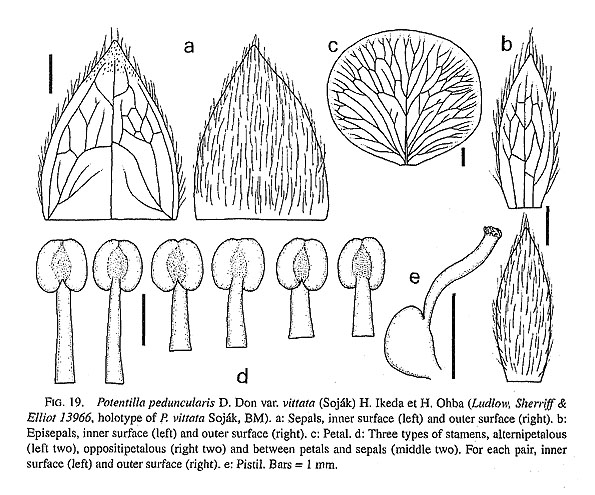
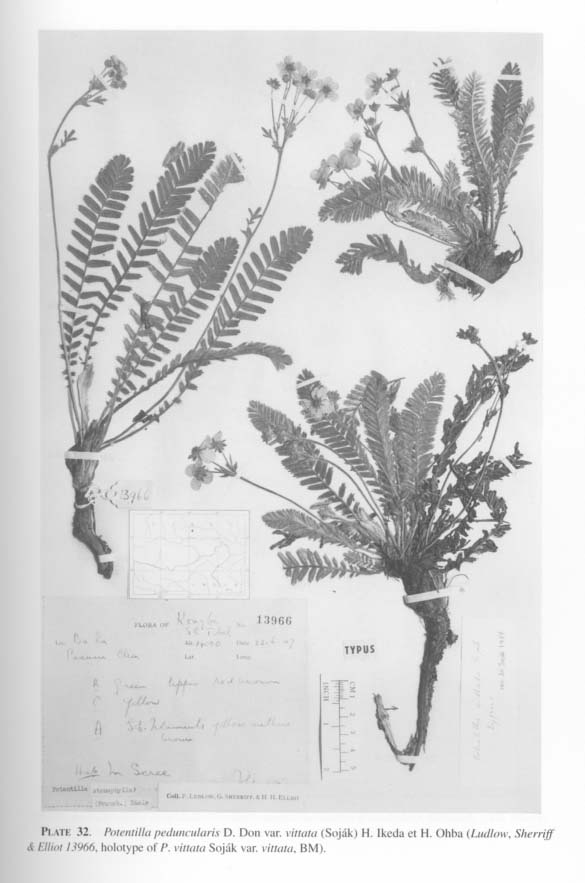
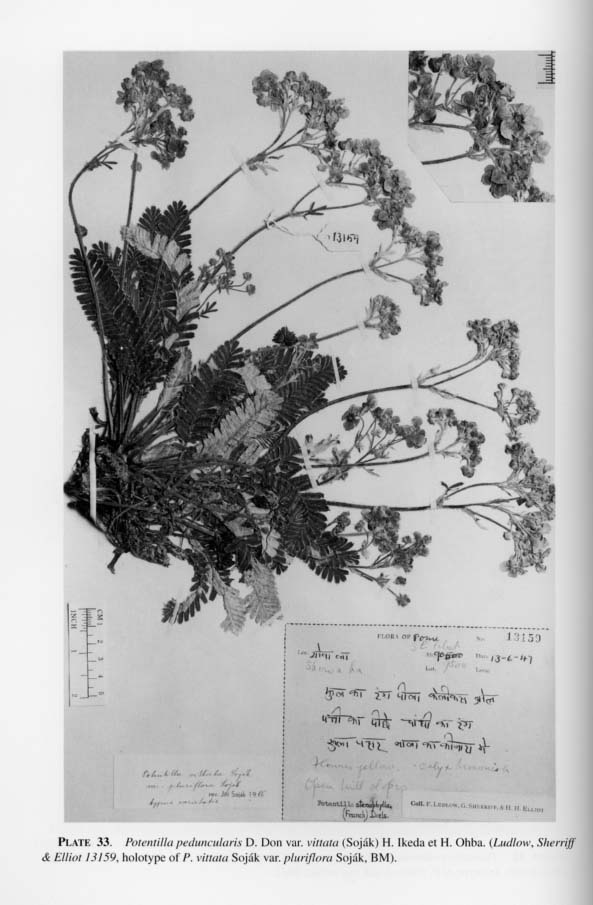
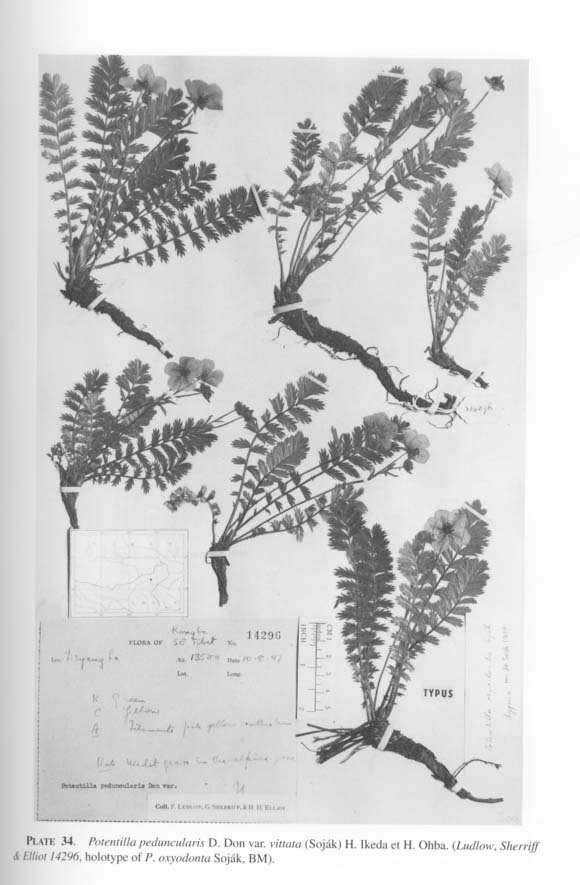
BASIONYM: P. vittata Soják var. vittata in Candollea 43: 164, t. 4, f. 2-4 (1988); in Bot. Jahrb. Syst. 116: 49 (1994).
Types: SE Tibet; Kongbo, Ba La, Pasum Chu, 14000 ft. (Ludlow, Sherriff & Elliot 13966, 22 June 1947, BM-holotype, E-isotype).
SYNONYMS: P. vittata Soják var. pluriflora Soják in Candollea 43: 166 (1988); in Bot. Jahrb. Syst. 116: 50 (1994).
Types: SE Tibet; Pome, Showa La, 9500 ft. (Ludlow, Sherriff & Elliot 13159, 13 June 1947, BM-holotype).
P. oxyodonta Soják in Candollea 43: 162, t. 4, f. 1; t. 5, f. 5 (1988); in Bot. Jahrb. Syst. 116: 48 (1994).
Types: SE Tibet; Deyang La, 13500 ft. (Ludlow, Sherriff & Elliot 14296, 10 Aug. 1947, BM-holotype, E-isotype).
P. vittata Soják var. abbreviata Soják in Bot. Jahrb. Syst. 116: 50 (1994).
Type: SE Tibet, Pome, Nambu La (30°00'-94°30') (Ludlow, Sherriff & Taylor 6959 in 1938, BM-holotype).
P. vittata Soják var. assidens Soják in Bot. Jahrb. Syst. 116: 50 (1994).
Type: Yunnan, Wei Hsi (McLaren's Coll. 15 ID in 1933, PR-holotype).
Radical leaves 5-20 cm long, 2.0-2.5 cm wide, lateral leaflets 18-25 pairs; petiole 1.5-4.0 cm long; terminal leaflet 6-8 mm long, 3-5 mm wide, with 5-7 teeth.
Peduncles 8-15 cm long; pedicel 1-3 cm long. Flowers 1.5-2.7 cm across; hy-panthium 8-13 mm across. Episepals 1.5-2.0 mm long, 0.7-1.0 mm wide. Sepals 2.0-2.5 mm long, 1.5-2.0 mm wide. Petals 3-4 mm long, 2.6-3.3 mm wide.
Stamens 1.2-1.4 mm long; anthers 0.4-0.5 mm long, 0.4-0.5 mm wide. Ovaries 0.5-0.6 mm long, 0.4-0.5 mm wide; styles 0.5-0.7 mm long.
Distr. Sikkim and China (Yunnan and Xizang).
Variety vittata is characterized by the dentate or relatively sparsely serrate leaflets. Although Soják (1988) described P. oxyodonta based on differences in the number of serrations, the number of seirations is variable and it difficult to separate var. vittata and P. oxyodonta.
13d. var. curta (Soják) H. Ikeda et H. Ohba, stat. et comb. nov. [Fig. 38]
BASIONYM: P. curta Soják in Bot. Jahrb. Syst. 116: 215 (1994).
Types: SE Tibet; Mt. Kenichungpo, Salwin-Irrawaddy divide (Rock 21971 in 1932, PR-holotype, A, E, US, NY-isotypes).
SYNONYM: P. stenophylla auct. non (Franch.) Diels; Fletcher in Notes Roy. Bot. Gard. Edinb. 20: 215 (1950), pro parte.
Radical leaves 2.5-14 cm long, 0.8-2.0 cm wide, lateral leaflets 5-16 pairs; terminal leaflet 0.5-1.0 cm long, 0.3-0.8 cm wide, dentate, with 3-7 teeth.
Peduncles 2-15 cm long; pedicel 1-3 cm long. Flowers 6-9 mm long, 6-8 mm wide.
Distr. China (Yunnan and Xizang).
Although var. curta has been identified as P. stenophylla, it differs from P. stenophylla by having stipules with a single auricle on the radical leaves; P. stenophylla has two free auricles on the stipules of the radical leaves.
14. Potentilla contigua Soják in Candollea 43: 160, t. 3, f. 1-4; t. 5, f. 1 & 2 (1988). Miehe, Langtang Himal 445, t. D2.49 (1990). Ikeda in Ohba and Akiyama, Alp. Fl. Jaljale Himal 35 (1992). [Figs. 20 & 39; Pls. 35-37]
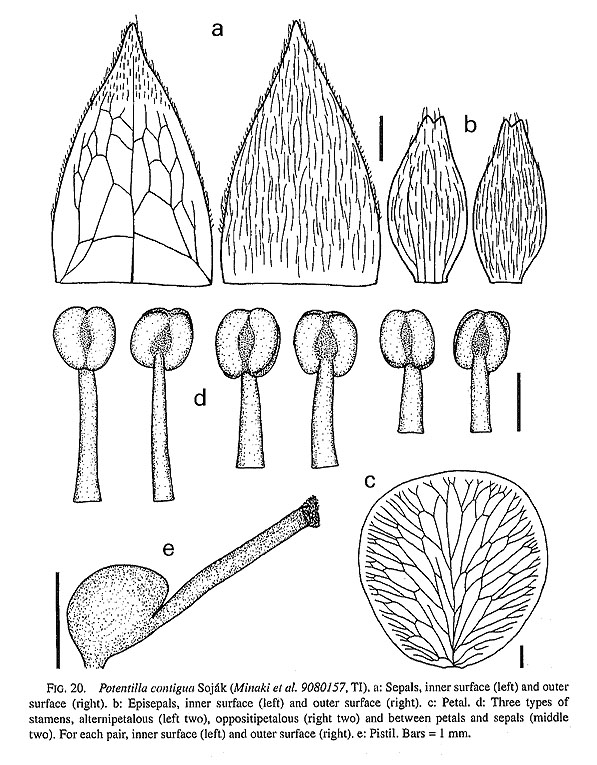
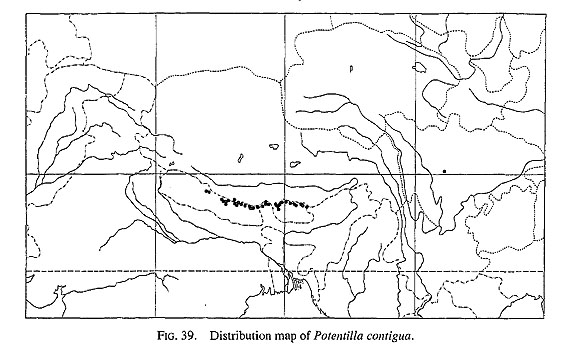
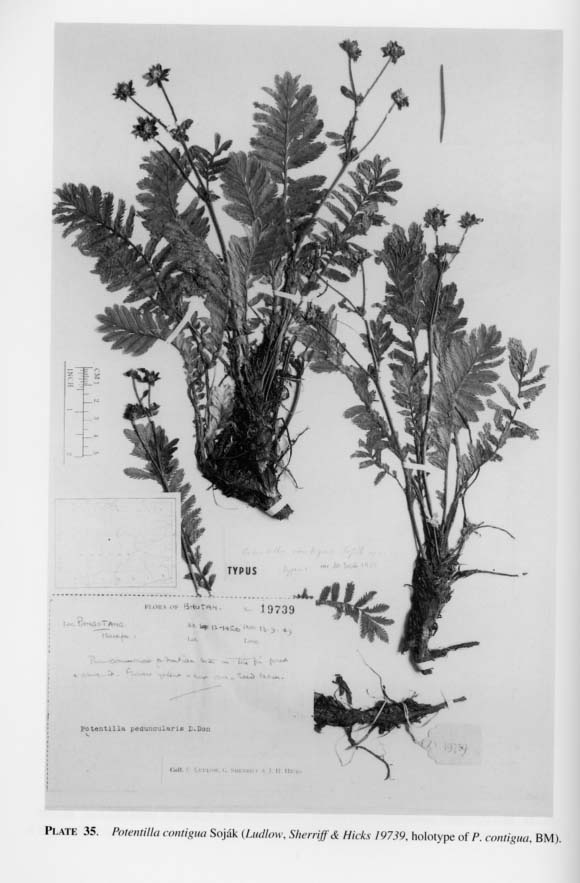
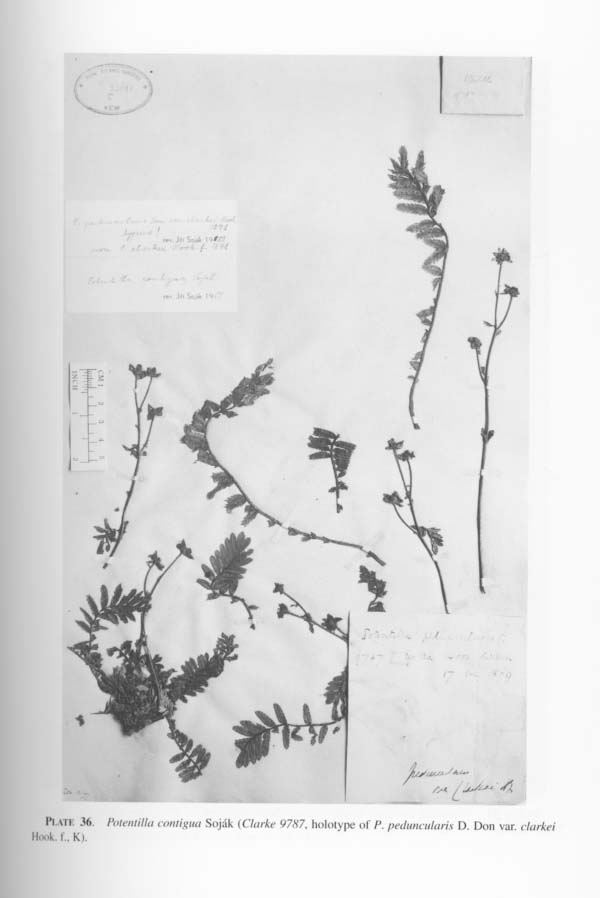
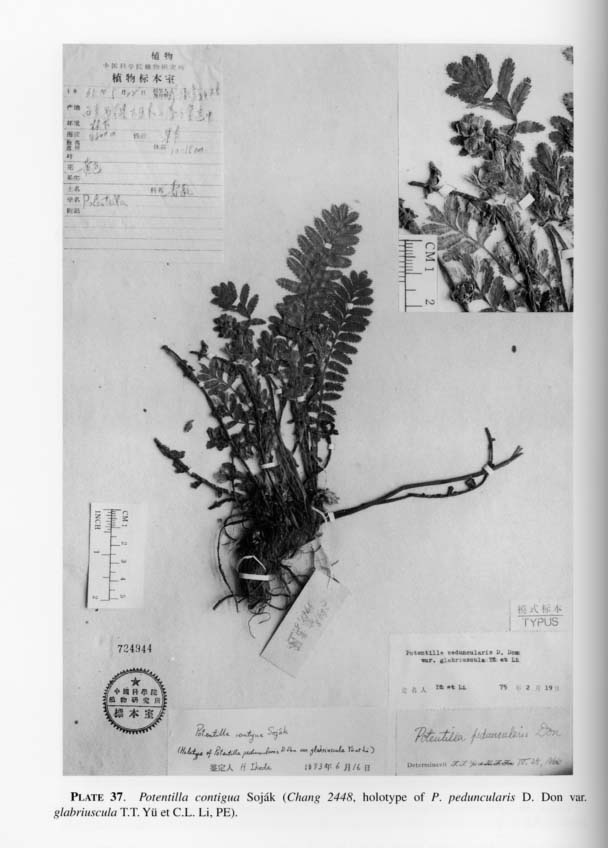
Type: Bhutan; Pangotang, Tsampa, 12000-14500 ft. (Ludlow, Sherriff & Hicks 19739, 13 Sept. 1949, BM-holotype).
SYNONYMS: P. peduncularis auct. non D. Don; Hook. f., Fl. Brit. Ind. 2: 351 (1878), pro parte.
P. peduncularis D. Don var. clarkei Hook. f., Fl. Brit. Ind. 2: 352 (1878). Wolf, Monogr. Potentilla 678 (1908). Murata in Hara, Fl. E. Himal. 2: 53 (1971). Grierson and Long, Fl. Bhutan 1: 572 (1987).
Type: Sikkim; Yakia, 14000 ft. (C. B. Clarke 9787, 17 Oct. 1869, K-holotype).
P. peduncularis D. Don var. glabriuscula T.T. Yü et C.L. Li in Acta Phytotax. Sin. 18: 7, t. 1, f. 3 (1980); in Yü, Fl. Reipubl. Popul. Sin. 37: 266 (1985). Yü et al. in Wu, Fl. Xizang. 2: 648 (1985).
Type: Tibet; Yadong, 3600 m (C. W. Chang 2448, 22 May 1964, PE-holotype).
Radical leaves oblanceolate, 10-20 cm long, 1.5-4.5 cm wide, lateral leaflets 13-16 pairs, usually without alternating smaller leaflets; base of uppermost pair of leaflets decurrent. Leaflets strigose beneath; terminal leaflet sessile, oblong to narrowly obo-vate, 1-2 cm long, 0.5-0.7 cm wide, serrate, with 11-15 teeth. Auricles of stipules free.
Peduncles 10-12 cm long. Cauline leaves with 3-5 pairs of leaflets. Auricles of stipules serrate, with 3-6 teeth.
Pedicel 1.5-4.0 cm long. Flowers 1.5-2.5 cm across; hypanthium 1.0-1.5 mm across. Episepals oblong to obovate, 4.0-5.0 mm long, 2.0-3.0 mm wide, entire or with 3 teeth, apex acute or obtuse, strigose on both surfaces. Sepals elliptic to ovate, 4.5-6.0 mm long, 3.5-4.5 mm wide, entire, apex acute or obtuse, puberulent toward apex above, lower surface and margin strigose. Petals oblong to elliptic, apex rounded, 9.5-10.5 mm long, 9.5-11.0 mm wide.
Stamens 1.3-2.5 mm long; anthers globose to ellipsoid, 1.1-1.3 mm long, 0.9-1.1 mm wide. Ovaries ellipsoid, 1.0-1.3 mm long, 0.8-1.0 mm wide; styles 1.6-2.0 mm long, slender; stigmas slightly inflated.
Chromosome number 2n=28.
Distr. Nepal, Sikkim, Bhutan, China (Sichuan and Xizang).
Although P. contigua is similar to P. peduncularis in habit, P. contigua has stipules of the radical leaves with two free auricles; P. peduncularis has one membranaceous auricle. Potentilla contigua and P. peduncularis often grow sympatrically in central and eastern Nepal, but the habitat preference of each species is different. Potentilla contigua prefers south-facing slopes in relatively dry, craggy places, while P. peduncularis prefers north-facing slopes in hollows of wet places.
15. Potentilla cardotiana Hand.-Mazz. in Acta Hort. Gothob. 13: 322 (1939). Soják in Candollea 43: t. 3, f. 8 (1988).
BASIONYM: P. leuconota D. Don var. corymbosa Card. in Not. Syst. 3: 241 (1916). H.Léveillé in Cat. Pl. Yun-Nan 232 (1917).
Type: China; Yunnan, Lo-pin Chan, c. 3200 m (Delavay s.n., 1 Sept. 1888, P-holo-type).
Radical leaves oblanceolate, 7-16 cm long, 2.5-3.5 cm wide, lateral leaflets 10-22 pairs, usually with alternating smaller leaflets; petiole 1.0-4.0 cm long; base of uppermost pair of leaflets decurrent. Leaflets silvery or golden sericeous beneath; terminal leaflet sessile, lanceolate to oblong, 1.0-2.0 cm long, 0.4-0.8 cm wide, serrate, with 15-38 teeth. Auricles of stipules free.
Peduncles 10-15 cm long. Cauline leaves with 1-6 pairs of leaflets. Auricles of stipules serrate, with 3-7 teeth.
Pedicel 1.5-2.0 cm long. Flowers 0.8-1.5 cm across; hypanthium 6-9 mm across. Episepals oblong to obovate, 1.5-5.0 mm long, 0.7-3.0 mm wide, entire or with 3 teeth, apex acute or obtuse, nearly glabrous above, sericeous beneath. Sepals elliptic to ovate, 2.0-6.0 mm long, 1.5-4.5mm wide, entire, apex acute or obtuse, puberulent toward apex above, sericeous beneath. Petals oblong to elliptic, apex rounded, 3.0-7.0 mm long, 2.6-5.5 mm wide.
Stamens 1.2-2.0 mm long; anthers globose to ellipsoid, 0.4-1.0 mm long, 0.4-0.9 mm wide. Ovaries ellipsoid, 0.5-0.8 mm long, 0.4-0.6 mm wide; styles 0.5-1,3 mm long, slender; stigmas slightly inflated.

15a. var. cardotiana [Figs. 21 & 40; Pl. 38]
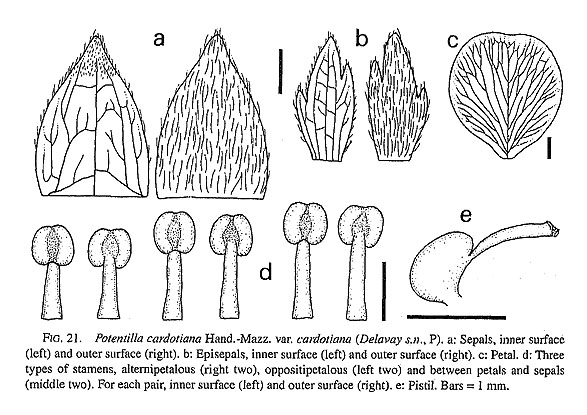
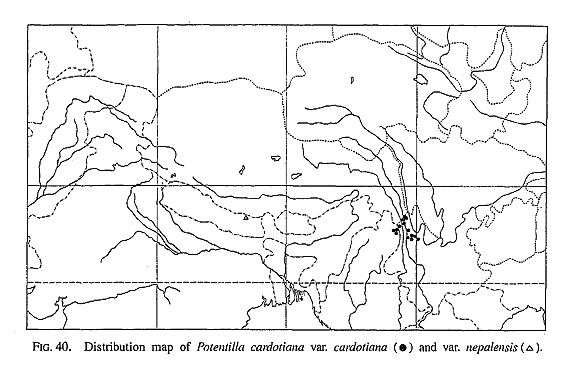
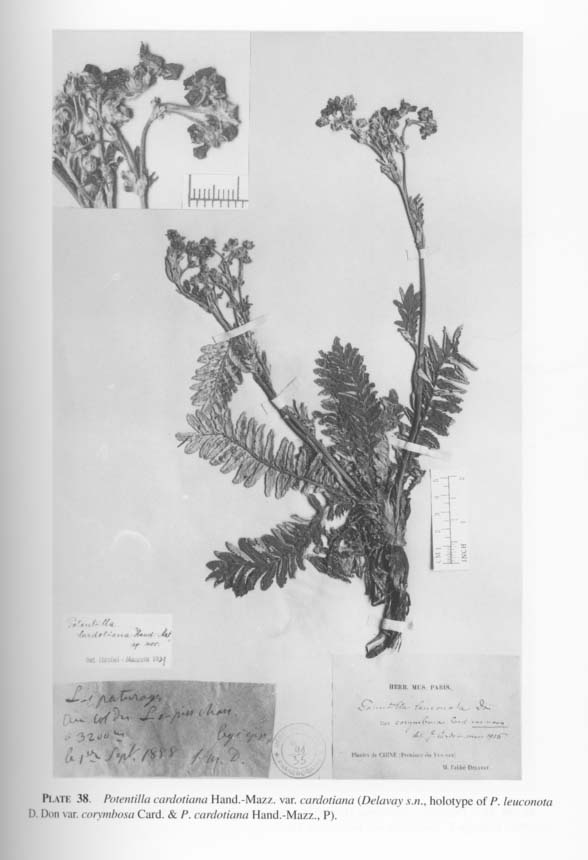
SYNONYM: P. peduncularis auct. non D. Don: Fletcher in Notes Roy. Bot. Gard. Edinb. 20: 213 (1950), pro parte. Yü and Li in Yü, Fl. Reipubl. Popul. Sin. 37: 265 (1985), pro major parte. Ku in Wang et al., Vasc. Pl. Hengduan Mts. 1: 848 (1993), pro major parte.
Radical leaves 10-13 cm long, 2.5-3.5 cm wide, lateral leaflets 15-18 pairs; petiole 1.0-1.5 cm long; terminal leaflet 1.2-2.0 cm long, 0.5-0.8 cm wide, with 15-20 teeth.
Peduncles 10-15 cm long; pedicel 1.5-2.0 cm long. Flowers 8-12 mm across; hypanthium 7-9 mm across. Episepals 1.5-2.0 mm long, 0.7-1.0mm wide. Sepals 2.0- 2.5 mm long, 1.5-2.0 mm wide. Petals 3-4 mm long, 2.6-3.3 mm wide.
Stamens 1.2-1.4 mm long; anthers 0.4-0.5 mm long, 0.4-0.5 mm wide. Ovaries 0.5-0.6 mm long, 0.4-0.5 mm wide; styles 0.5-0.7 mm long.
Distr. N Myanmar and China (Yunnan).
Potentilla cardoliana was first described as P. leuconota var. corymbosa (Cardot 1914). The radical leaves of P. cardotiana have two free auricles, while the auricles of the radical leaves of P. leuconota are connate from the base to the middle. Many specimens of P. cardotiana collected in China were identified as P. peduncularis.
15b. var. nepalensis H. Ikeda et H. Ohba, var. nov. [Figs. 22 & 40; Pl. 39]
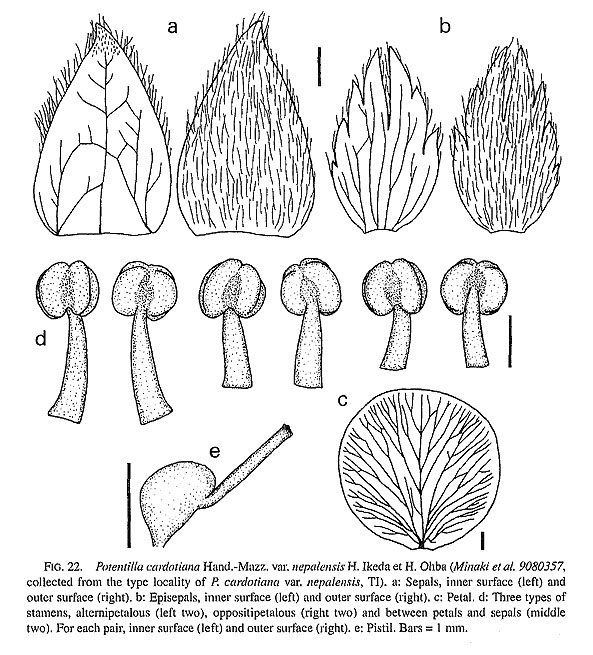
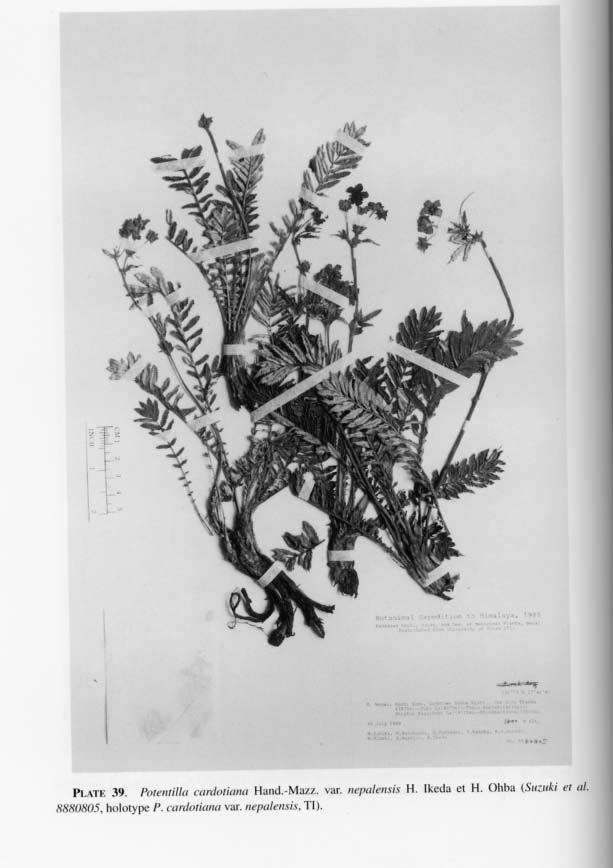
A typo pilis foliolis infra argenteis (nec aureis) obtegentibus differt.
Types: E Nepal; Koshi Zone, Sankhuwa Sabha Distr., Cha Ding Kharka - Khongma, 3800 m (Suzuki et al. 8880805, 30 July 1988, TI-holotype, A, BM, E, KATH-isotypes).
Radical leaves 7-16 cm long, 2-3 cm wide, lateral leaflets 10-22 pairs; petiole 2-4 cm long; terminal leaflet 1-2 cm long, 4-7 mm wide.
Peduncles 10-15 cm long; pedicel 1.5-2.0 cm long. Flowers 1.0-1.5 cm across; hy-panthium 6-9 mm across. Episepals 3.0-5.0mm long, 1.5-3.0 mm wide. Sepals 4-6 mm long, 2.5-4.5 mm wide. Petals 5-7 mm long, 4.0-5.5 mm wide.
Chromosome number 2n=14.
Distr. E Nepal.
Variety nepalensis differs from var. cardotiana in size and in the indumentum of the leaflets. Variety nepalensis (15-30 cm tall) is smaller than var. cardotiana (20-40 cm tall). The hairs on the lower surface of the leaves of var. nepalensis are silvery; those of var. cardotiana are gold. Variety nepalensis is restricted to the upper Arun Valley, E Nepal.






 . Nár. Muz. Odd.
. Nár. Muz. Odd.  . 152: 160 (1983).
. 152: 160 (1983).































